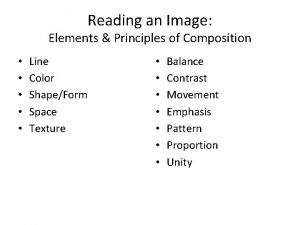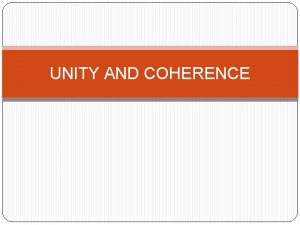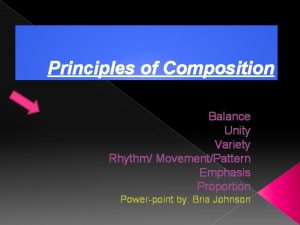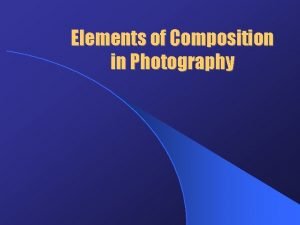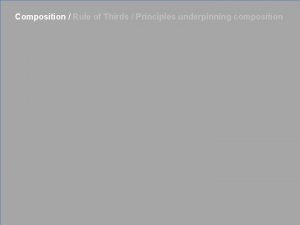Unity Composition Variety The organization of elements in



















- Slides: 19

Unity Composition: Variety The organization of elements in a work, aka, the design. Repetition Rhythm Balance Emphasis/Focal Point Proportion/Scale

Unity: The sense of oneness, of things belonging together and making up a coherent whole. Variety: Differences that provide interest and contrast. Ben Jones, Black Face and Arm Unit, 1971.

Symmetrical Balance: Mirror image of Shapes/Forms on either side of an imaginary axial dividing line. Elements correspond to one another in size, shape, and placement. Tori Busshi, Shaka Triad, 623.

Relieved Symmetry: or Approximate Symmetry: Slight differences between axial areas of a work. Frida Kahlo, The Two Fridas, 1939.

Asymmetrical Balance: Two sides that do not correspond to one another in size, shape, and placement. Gustav Klimt, Death and Life, Before 1911 -1915.

Sakai Hoitsu, late 18 th-early 19 th century.

Emphasis: The viewer’s attention will be centered more on certain parts of the composition than on others. Focal Point: A specific spot to which one’s attention is directed. Subordination: A less visually interesting area. Henry Tanner, The Banjo Lesson, 1893.

Emphasis: The viewer’s attention will be centered more on certain parts of the composition than on others. Focal Point: A specific spot to which one’s attention is directed. Paul Cézanne, Still Life With Compotier, Pitcher and Fruit, 1892 -94.

Scale: Size in relation to a constant or “normal” size. Proportion: Refers to size relationships between parts of a whole or between two or more items perceived as a unit. Rene Magritte, Delusions of Grandeur II, 1948.

Benin, A Royal Altar to the Hand, 18 th century.

Proportions of the golden section Leonardo da. Vinci, The Study of Human Proportions According to Vetruvius, c. 1485 -90.

Visual Rhythm: Depends on the repetition of accented elements, usually shapes. Peit Mondrian, Broadway Boogie-Woogie, 1942 -43.

Unity Variety Repetition Rhythm Balance Emphasis/Focal Point Proportion/Scale Pablo Picasso, Girl Before a Mirror

The Parthenon, Athens Greece

Nike of the Samothrace, Louvre, Paris Pablo Picasso, Weeping Woman

Black Figure Pottery, Ancient Greece Marcel Duchamp, Nude Descending a Staircase

Andy Warhol, 10 Marilyns

Jackson Pollock, Number 5

 Rhythm by transition drawing
Rhythm by transition drawing Starry night harmony unity and variety
Starry night harmony unity and variety Unity in composition
Unity in composition Process organization in computer organization
Process organization in computer organization Organization by point
Organization by point Elements and principles of composition
Elements and principles of composition The area used or unused in a composition
The area used or unused in a composition Vcaa theatre studies study design
Vcaa theatre studies study design Hình ảnh bộ gõ cơ thể búng tay
Hình ảnh bộ gõ cơ thể búng tay Bổ thể
Bổ thể Tỉ lệ cơ thể trẻ em
Tỉ lệ cơ thể trẻ em Voi kéo gỗ như thế nào
Voi kéo gỗ như thế nào Glasgow thang điểm
Glasgow thang điểm Chúa sống lại
Chúa sống lại Môn thể thao bắt đầu bằng chữ f
Môn thể thao bắt đầu bằng chữ f Thế nào là hệ số cao nhất
Thế nào là hệ số cao nhất Các châu lục và đại dương trên thế giới
Các châu lục và đại dương trên thế giới Công thức tiính động năng
Công thức tiính động năng Trời xanh đây là của chúng ta thể thơ
Trời xanh đây là của chúng ta thể thơ





